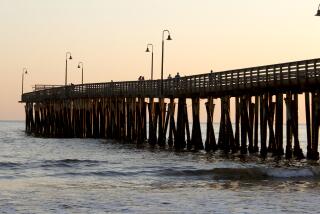Plan for Hunt Resort at Lagoon Revealed : Hotel, Golf Course, Housing Seen as Harmful to Environment by State Officials
- Share via
CARLSBAD — After almost two years of work in a climate thick with curiosity and controversy, the billionaire Hunt brothers on Friday unveiled their long-awaited master plan for the resort and residential development they hope to build on the shore of Batiquitos Lagoon.
In a project that could rival the famed La Costa resort, Texas oil magnates W. Herbert and Nelson Bunker Hunt plan to build a golf course, hotel and residential units on 1,740 acres they own north of the lagoon between El Camino Real and Interstate 5. Company officials hope to begin construction of the Pacific Rim Country Club and Resort by early next year and complete work within 20 years.
“I’m extremely proud of our master plan and of the spectacular amenities we’re going to provide the community,” said D.L. (Larry) Clemens, vice president of the company owned by the Hunts, who are best known for their reputed attempt to corner the world silver market in 1980. “This is a very special time.”
Despite such an upbeat endorsement and the impressive charts and maps that accompanied its unveiling at an afternoon press conference, the master plan contains several features sure to bog the Hunts in further controversy when they present it to the California Coastal Commission and other agencies over the next year.
On Friday, however, company officials said they do not believe that those issues, including management of Batiquitos Lagoon, preservation of land for agriculture and construction of a road through an environmentally sensitive area, stand in the way of development of the property.
Central to their plans is “enhancement” of Batiquitos Lagoon, which they own and which they contend is a “dying” resource and a liability for the development in its current state.
The lagoon undergoes seasonal fluctuations in water level, and during the summer it nearly dries up and produces an unpleasant odor. In order to make the lagoon more aesthetically pleasing, the company proposes to install a pumping system that would keep it filled with water year-round.
“We believe it is gradually turning from a lagoon into a meadow,” said Robert Kaufman of Gruen Associates, the firm that prepared the Hunts’ master plan. “Our biologists contend it is a dying lagoon.”
Environmentalists and state Department of Fish and Game officials, however, disagree. They say the lagoon has dried up seasonally for more than 100 years, and worry that the Hunts’ “enhancement” might upset the delicate ecological balance in the lagoon.
Specifically, they fear that a year-round infusion of water would eliminate shallow areas that are the habitat for many bird species, including several on the state’s endangered list.
Another aspect of the plan that raises the ire of Fish and Game officials is a road the company hopes to construct along the lagoon’s northern edge. Called Lagoon Lane, the road currently is a rarely used dirt track, part of which is under water during the winter.
Under the master plan, the lane would become a two-lane “meandering scenic route” along the north shore designed to provide “visual access and enjoyment of the . . . lagoon.”
Fish and Game biologist Earl Lauppe contends that the road, as planned, would cut through wetland areas protected under the state Coastal Act. “That road’s under water right now, so it seems pretty clear they’re messing with the wetlands,” Lauppe said.
Under the Coastal Act guidelines, he said, a 100-foot buffer is required between sensitive areas and any development. As planned, the road would at some points wind to within one foot of the water.
The plan’s lack of land designated for agriculture is still another area of contention destined to cause the Hunts trouble with the Coastal Commission.
“There is no agricultural land in our plan because farming is not economically viable in the area,” Clemens said. “To the Hunts, this simply is not an issue.”
Coastal Commission officials, however, may stand firm on their mission to retain some Carlsbad land in agriculture in perpetuity. Under Proposition 20, passed by voters in 1972, the commission is charged with preserving farmland along the coast.
The unveiling Friday came an hour after the plan was presented to Carlsbad city officials and a little more than a week after William Herbert Hunt flew west to make a personal pitch for his ambitious project. Speaking before the Carlsbad Rotary Club and a flock of reporters, Hunt bemoaned the myriad agencies that have a say over development of the resort and pleaded for smooth processing of plans in the future.
On Tuesday, the Carlsbad City Council is expected to formally annex the Hunts’ property into the city. Earlier, the company had requested a delay of the annexation because of the city’s pending review of its general plan, new city density restrictions and the election of slow-growth advocate Mark Pettine to the council.
More to Read
Sign up for Essential California
The most important California stories and recommendations in your inbox every morning.
You may occasionally receive promotional content from the Los Angeles Times.










